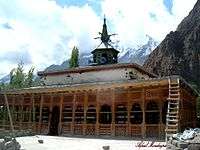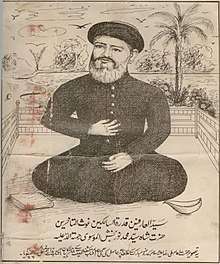Muhammad Nurbakhsh Qahistani
Mir Sayyid Muhammad Nurbakhsh Qahistani (1392-1464; Arabic: محمد بن عبد الله الموسوئی قہستانی ) was a mystic (Sufi) who gave name to the Noorbakshia school of Islam. He wrote al Fiqh al-Ahwat (Islamic Jurisprudence) and Kitab al-Aetiqadia (Book of Faith).
Muhammad Nurbakhsh Qahistani | |
|---|---|
| Personal | |
| Born | Friday 27 Muharram 795 (December 13, 1392 CE)[1] |
| Died | AH 869 (1464/1465) [2] |
| Religion | Islam |
| Ethnicity | Iran |
| Era | Modern era |
| Region | Asia |
| Jurisprudence | Sufism |
| Creed | The Twelve Imams |
| Main interest(s) | Aqeedah, Fiqh, Tasawwuf |
| Occupation | Islamic scholar |
| Muslim leader | |
Influenced by
| |
Influenced
| |
| Part of a series on Sufi Islam |
| Noorbakhshia |
|---|
 |
|
Concepts |
|
History
|
Life

Nurbakhsh's real name was Muhammad bin Abdullah. His father was born in Qain and his grand father in al-Hasa, whence in some ghazals (lyrics) he styles himself as Lahsavi (one from al-Hasa). His father migrated from Bahrain to Qain in Qahistan, where Nurbakhsh was born in 795 A.H. (1393 C.E.). Thus his full name as appeared in his prose works is Sayyid Muhammad Nurbakhsh Qahistani.
Nurbakhsh became a disciple of Sayyid Ishaq al-Khatlani, himself a disciple of Mir Sayyid Ali Hamadani.[3] Through his writings Nurbakhsh made an attempt to bridge the gap between the orthodox Sunni'ism and Shi'ism and gave an Islamic Fiqh of religious moderation in his book titled Al-Fiqh al-Ahwat (Moderate Islamic Jurisprudence).[4][5]
Works
Syed Muhammad Nurbakhsh wrote of about 150 works in Arabic or Persian.
- Al-Fiqh Al-Ahwat (Islamic Jurisprudence)
- Kitab al-Aetiqadia (Book of Faith)
- Silsila Dhahab (in Arabic and Persian)
- Risal fi Ilm Firasat or Insan-nama
- Kashf al-Haqaeeq
- Risala Maash al-Salikeen
- Makarim al-Akhlaq
- Silsila al-Auliya (Arabic)
- Risala Nooria or Nur al-Haq
- Risala Miraajia (Persian)
- Risal al Huda (Arabic)
- Risala Irfani (Persian)
- Risala Aqsam-e-Dil (Persian)
See also
- Hacı Bektaş-i Veli
References
- Walbridge, Linda S. (2001-08-06). The Most Learned of the Shi'a : The Institution of the Marja' Taqlid: The. ISBN 9780195343939.
- Stellrecht, Irmtraud (1997). The Past in the Present: Horizons of Remembering in the Pakistan Himalaya. ISBN 9783896451521.
- Deweese, Devin (2014). "Intercessory Claims of Sufi Communities: Messianic Legitimizing Strategies on the Spectrum of Normativity". In Mir-Kasimov, Orkhan (ed.). Unity in Diversity: Mysticism, Messianism and the Construction of Religious Authority in Islam. Brill. pp. 197–220. ISBN 978-90-04262-80-5.
- Dr. Reick Andreas: "Nurbakhshis of Baltistan-Revival of the Oldest Muslim Community in the Northern Areas of pakistan", paper read at the International Conference "Karakurum-Himalaya-Hindukush- Dynamic of Change", National Library Islamabad 29.9 to 2.10.1995
- and further in the Article by Sajjad, Hussain Balghari:"Sayyid Muhammad Nurbakhsh Qahistani", Nawa-i-Sufia Islamabad, Issue No. 12, 1995
- {{http://www.citypedia.ir/%D8%A7%D9%85%D8%A7%D9%85%D8%B2%D8%A7%D8%AF%D9%87-%D8%B3%DB%8C%D8%AF-%D9%85%D8%AD%D9%85%D8%AF-%D9%86%D9%88%D8%B1%D8%A8%D8%AE%D8%B4-%D8%AF%D8%B1-%D8%B3%D9%88%D9%84%D9%82%D8%A7%D9%86/}}
External links
- Sufia Nurbakhshia: Messianic Hopes and Mystical Visions,Shahzad Bashir - 2003